Lava fountaining activity continues from the western vent in Halema‘uma‘u, within Kīlauea summit caldera, viewed at dusk on October 10, 2021, from the west rim of the crater. Only the western half of the lake surface is active; the eastern half is covered by a cooling, solidified crust. USGS image by B. Carr.
Images
Settings
Explore our planet through photography and imagery, including climate change and water all the way back to the 1800s when the USGS was surveying the country by horse and buggy.

Lava fountaining activity continues from the western vent in Halema‘uma‘u, within Kīlauea summit caldera, viewed at dusk on October 10, 2021, from the west rim of the crater. Only the western half of the lake surface is active; the eastern half is covered by a cooling, solidified crust. USGS image by B. Carr.

Fountaining at the western vent in Halema‘uma‘u crater, at Kīlauea volcano's summit, was approximately 15 meters (50 feet) high on the evening of October 10, 2021. Spatter from the fountaining would occasionally land on the wall of the vent cone and cool (visible on the right).
Fountaining at the western vent in Halema‘uma‘u crater, at Kīlauea volcano's summit, was approximately 15 meters (50 feet) high on the evening of October 10, 2021. Spatter from the fountaining would occasionally land on the wall of the vent cone and cool (visible on the right).
HVO scientists captured this zoomed-in photo of the western fissure within Halema‘uma‘u through the lens of a laser rangefinder on October 9, 2021. The fissure has formed a horseshoe-shaped spatter cone around its source, with an opening on the east (right) side allowing lava to flow into the active lava lake.
HVO scientists captured this zoomed-in photo of the western fissure within Halema‘uma‘u through the lens of a laser rangefinder on October 9, 2021. The fissure has formed a horseshoe-shaped spatter cone around its source, with an opening on the east (right) side allowing lava to flow into the active lava lake.
Natural Resource Economist coloring page.
Though not every ānuenue (rainbow) has an actively erupting volcanic fissure at its end, this one did for a brief moment during HVO scientists' helicopter overflight of the Kīlauea summit on the morning of October 8, 2021.
Though not every ānuenue (rainbow) has an actively erupting volcanic fissure at its end, this one did for a brief moment during HVO scientists' helicopter overflight of the Kīlauea summit on the morning of October 8, 2021.
On the morning of October 8, 2021, HVO scientists completed a routine helicopter overflight of the ongoing eruption within Halema‘uma‘u at the summit of Kīlauea.
On the morning of October 8, 2021, HVO scientists completed a routine helicopter overflight of the ongoing eruption within Halema‘uma‘u at the summit of Kīlauea.
In this overflight photo of the Halema‘uma‘u lava lake, captured on October 8, 2021 and looking from the northeast, two western fissures are visible: one inactive from the December 2020–May 2021 Kīlauea summit eruption (center), and another actively feeding lava into the lake at this time (upper-right).
In this overflight photo of the Halema‘uma‘u lava lake, captured on October 8, 2021 and looking from the northeast, two western fissures are visible: one inactive from the December 2020–May 2021 Kīlauea summit eruption (center), and another actively feeding lava into the lake at this time (upper-right).
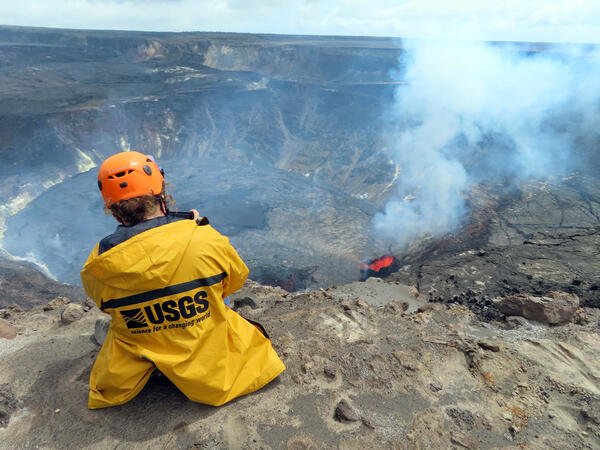
USGS scientist takes video of the erupting west vent within Halema‘uma‘u crater, at the summit of Kīlauea. Photo taken from the northwest rim of Halema‘uma‘u at 12:27 p.m. HST on Oct. 8, 2021. USGS photo by J.M. Chang.
USGS scientist takes video of the erupting west vent within Halema‘uma‘u crater, at the summit of Kīlauea. Photo taken from the northwest rim of Halema‘uma‘u at 12:27 p.m. HST on Oct. 8, 2021. USGS photo by J.M. Chang.
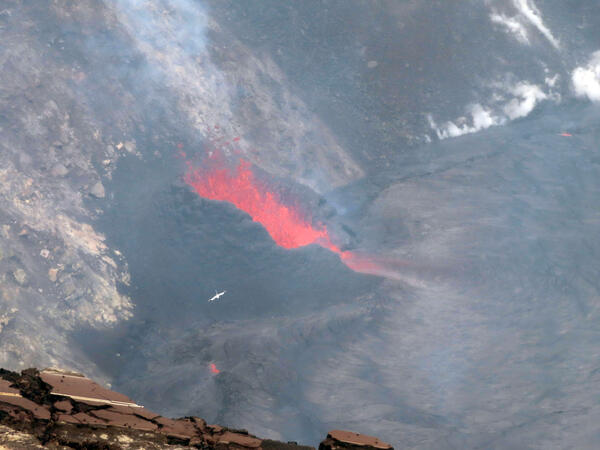
A Koa‘e Kea (white-tailed tropicbird) flies above the erupting west vent within Halema‘uma‘u crater, at the summit of Kīlauea. Photo taken from the south rim of Halema‘uma‘u at 10:41 a.m. HST on Oct. 8, 2021. USGS photo by J.M. Chang.
A Koa‘e Kea (white-tailed tropicbird) flies above the erupting west vent within Halema‘uma‘u crater, at the summit of Kīlauea. Photo taken from the south rim of Halema‘uma‘u at 10:41 a.m. HST on Oct. 8, 2021. USGS photo by J.M. Chang.
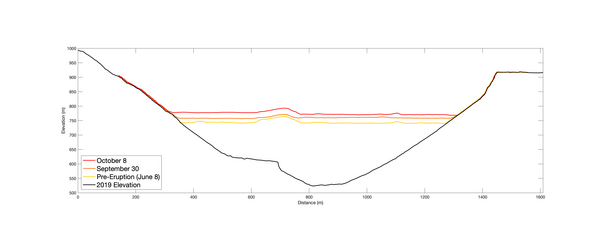
The elevation profiles running East-West across Halema‘uma‘u crater show the rise of the lava lake surface during the ongoing eruption at the summit of Kīlauea. The lake lake is now about 260 m (850 feet) deep, and has risen nearly 30 m (98 feet) above the previous lake surface since the eruption began on September 29.
The elevation profiles running East-West across Halema‘uma‘u crater show the rise of the lava lake surface during the ongoing eruption at the summit of Kīlauea. The lake lake is now about 260 m (850 feet) deep, and has risen nearly 30 m (98 feet) above the previous lake surface since the eruption began on September 29.
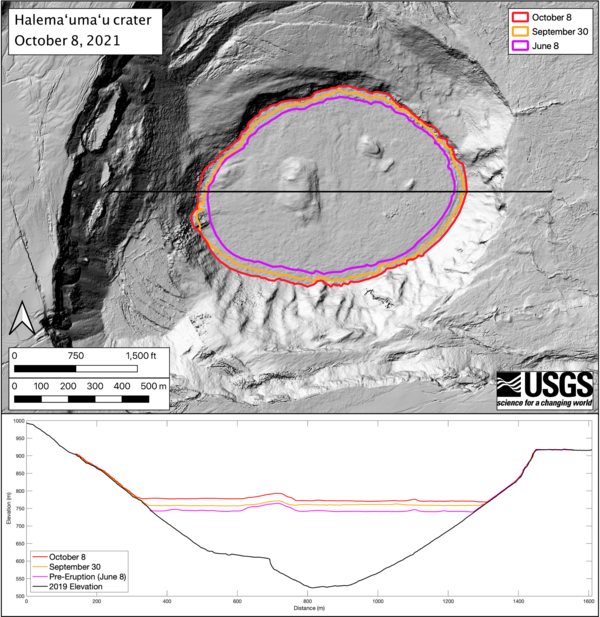
The eruption within Halema‘uma‘u crater, at Kīlauea's summit, continues to feed a growing lava lake. Photos taken during helicopter overflights of the crater allow HVO scientists to create elevation maps of the rising lake’s surface. The surface area of the Halema‘uma‘u lava lake is now 553000 square meters, or 157 acres.
The eruption within Halema‘uma‘u crater, at Kīlauea's summit, continues to feed a growing lava lake. Photos taken during helicopter overflights of the crater allow HVO scientists to create elevation maps of the rising lake’s surface. The surface area of the Halema‘uma‘u lava lake is now 553000 square meters, or 157 acres.
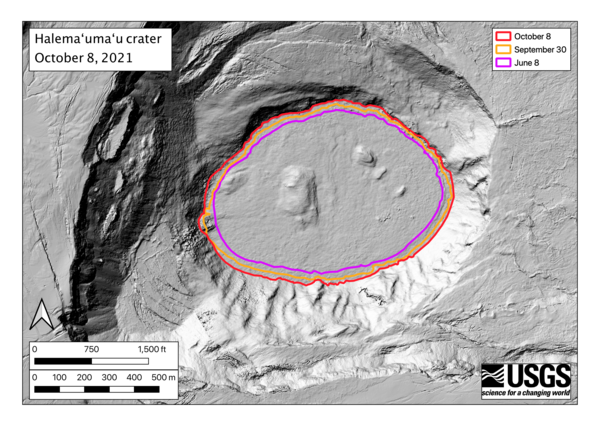
The surface area of the Halema‘uma‘u lava lake at the summit of Kīlauea is now 553,000 square meters, or 157 acres. At its widest point, the lake is a kilometer wide (0.62 mile).
The surface area of the Halema‘uma‘u lava lake at the summit of Kīlauea is now 553,000 square meters, or 157 acres. At its widest point, the lake is a kilometer wide (0.62 mile).
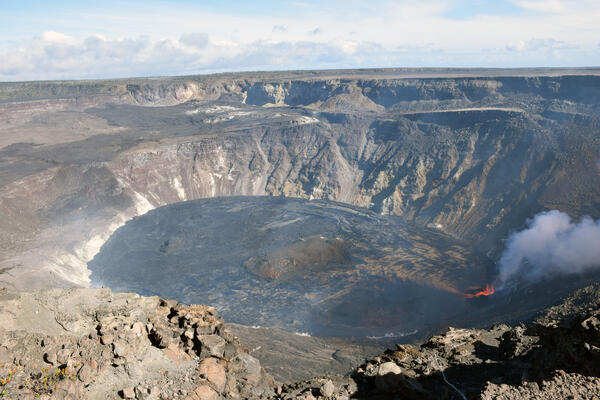
A wide view of the ongoing Kīlauea summit eruption within Halema‘uma‘u, taken from the northwest rim of the crater. The west vent lava fountains (right) continues to supply lava into the slowly rising lava lake. Lava fountaining is no longer visible through the central and southern portions of the lava lake surface.
A wide view of the ongoing Kīlauea summit eruption within Halema‘uma‘u, taken from the northwest rim of the crater. The west vent lava fountains (right) continues to supply lava into the slowly rising lava lake. Lava fountaining is no longer visible through the central and southern portions of the lava lake surface.
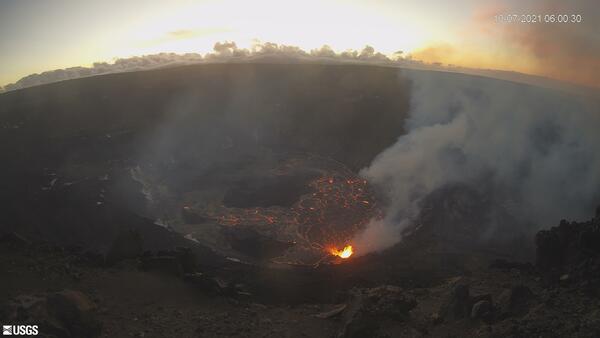
KWcam image taken on October 7, 2021, just after 6 a.m. HST. This image shows the ongoing eruption within Halemaʻumaʻu crater at the summit of Kīlauea. The eruption began the afternoon of September 29, 2021, as fissures in the floor of the crater; this activity is generating a lava lake that is slowly filling the crater.
KWcam image taken on October 7, 2021, just after 6 a.m. HST. This image shows the ongoing eruption within Halemaʻumaʻu crater at the summit of Kīlauea. The eruption began the afternoon of September 29, 2021, as fissures in the floor of the crater; this activity is generating a lava lake that is slowly filling the crater.
The eruption continues in Halema‘uma‘u crater, at the summit of Kīlauea. Lava fountaining no longer emerges from the central portion of the lake, with fountaining limited to the west vent shown here. Low fountaining within the cone supplies lava into the lake via a short spillway. USGS image by M. Patrick.
The eruption continues in Halema‘uma‘u crater, at the summit of Kīlauea. Lava fountaining no longer emerges from the central portion of the lake, with fountaining limited to the west vent shown here. Low fountaining within the cone supplies lava into the lake via a short spillway. USGS image by M. Patrick.
A view of the west vent in Halema‘uma‘u crater, at the summit of Kīlauea. This photo was taken from the northwest caldera rim, providing a good view inside the cone, as well as a view of the small spillway supplying lava into the lake. USGS photo by M. Patrick.
A view of the west vent in Halema‘uma‘u crater, at the summit of Kīlauea. This photo was taken from the northwest caldera rim, providing a good view inside the cone, as well as a view of the small spillway supplying lava into the lake. USGS photo by M. Patrick.
This photo from Thursday, October 7, shows the lava lake near the western vent in Halema‘uma‘u crater, at the summit of Kīlauea. The zig zag pattern separating the crustal plates is evident here, as are several spreading zones which cut across the pattern. USGS photo by M. Patrick.
This photo from Thursday, October 7, shows the lava lake near the western vent in Halema‘uma‘u crater, at the summit of Kīlauea. The zig zag pattern separating the crustal plates is evident here, as are several spreading zones which cut across the pattern. USGS photo by M. Patrick.
Late afternoon sunlight illuminates the main island in the lava lake in Halema‘uma‘u crater, at the summit of Kīlauea. The island formed in the previous summit eruption (December 2020-May 2021), and was covered with fresh spatter during the opening stages of the current eruption. USGS photo by M. Patrick.
Late afternoon sunlight illuminates the main island in the lava lake in Halema‘uma‘u crater, at the summit of Kīlauea. The island formed in the previous summit eruption (December 2020-May 2021), and was covered with fresh spatter during the opening stages of the current eruption. USGS photo by M. Patrick.
The eruption continues in Halema‘uma‘u crater, at Kīlauea summit. This view from the southern crater rim shows the west vent fountains (center) supplying lava into the western portion of the lava lake. SO2 gas emission rates remain elevated, and were measured at 4,700 tonnes per day on October 7. USGS photo taken by L.
The eruption continues in Halema‘uma‘u crater, at Kīlauea summit. This view from the southern crater rim shows the west vent fountains (center) supplying lava into the western portion of the lava lake. SO2 gas emission rates remain elevated, and were measured at 4,700 tonnes per day on October 7. USGS photo taken by L.
A large crustal foundering event in Kīlauea's ongoing Halema‘uma‘u eruption occurred in the late afternoon on October 6, 2021. This photo was taken from the northwest crater rim looking east across the lava lake. USGS Photo: K. Lynn
A large crustal foundering event in Kīlauea's ongoing Halema‘uma‘u eruption occurred in the late afternoon on October 6, 2021. This photo was taken from the northwest crater rim looking east across the lava lake. USGS Photo: K. Lynn
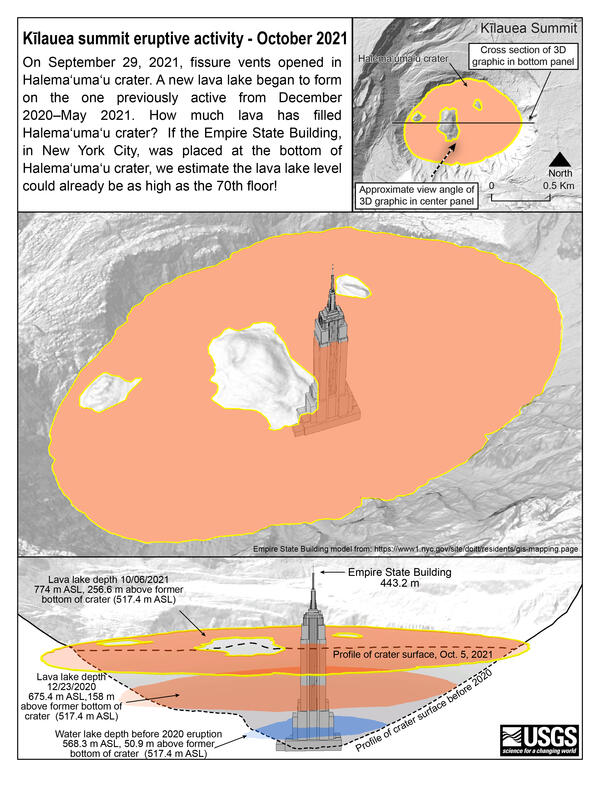
On September 29, 2021, fissure vents opened in Halema‘uma‘u crater. A new lava lake began to form on the one previously active from December 2020–May 2021.
On September 29, 2021, fissure vents opened in Halema‘uma‘u crater. A new lava lake began to form on the one previously active from December 2020–May 2021.












